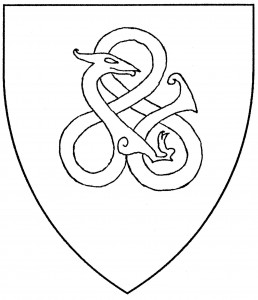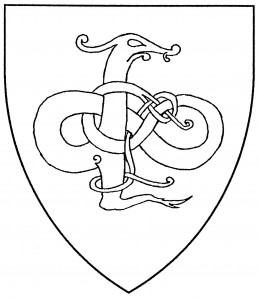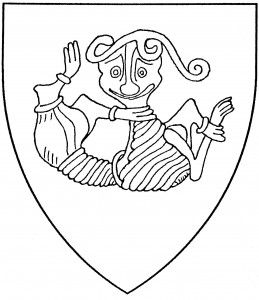Norse beasts, or Norse serpents, are a class of monster characterized by long sinuous bodies, one or two legs (front and back), and a complex interlacing. Some forms also have a head lappet or pigtail, which if long may be interlaced with the rest of the body. Further details of Norse beasts are usually blazoned by the drawing style of their original sources; such drawing styles carry no heraldic difference.
The most common style of drawing Norse beasts is the “Urnes style”; it takes its name from the decorations of a small church in the Norwegian village of Urnes. The Society-default Norse beast is blazoned a “Norse serpent nowed”, and is drawn in the Urnes style. The charge is based on a carving on the Sjua stone, c.1190.
Other styles of drawing Norse beasts include the “Jellinge” style, the “Ringerike” style, and the “Borre” style. These terms are usually included only for the artist’s sake. The “Norse Jelling-beast nowed” is actually not in the Jellinge style; but the blazon may be used to define this particular Norse beast. The charge is based on a design on a silver bowl from Lilla Valla, Gotland, c.1050.
Finally, there are individual creatures which, though found in Norse art, are not nowed or interlaced. An example is the “Lisbjerg gripping beast”, which is taken from a pair of 9th C. oval brooches found in Lisbjerg, Jutland.
None of the styles of Norse beast are presently permitted in Society heraldry. The terms are too obscure, and previous blazons have no uniformity; they convey no information to the artist or herald. For related charges, see orm, serpent.
Brynhildr Kormaksdottir bears: Gules, a Norse serpent nowed Or.
Bjorn of Havok bears: Counter-ermine, a Lisbjerg gripping beast gules.
Asbjorn Gustavsson of Roed bears: Azure, a “Norse Jelling-beast” nowed, erect and reversed argent.


